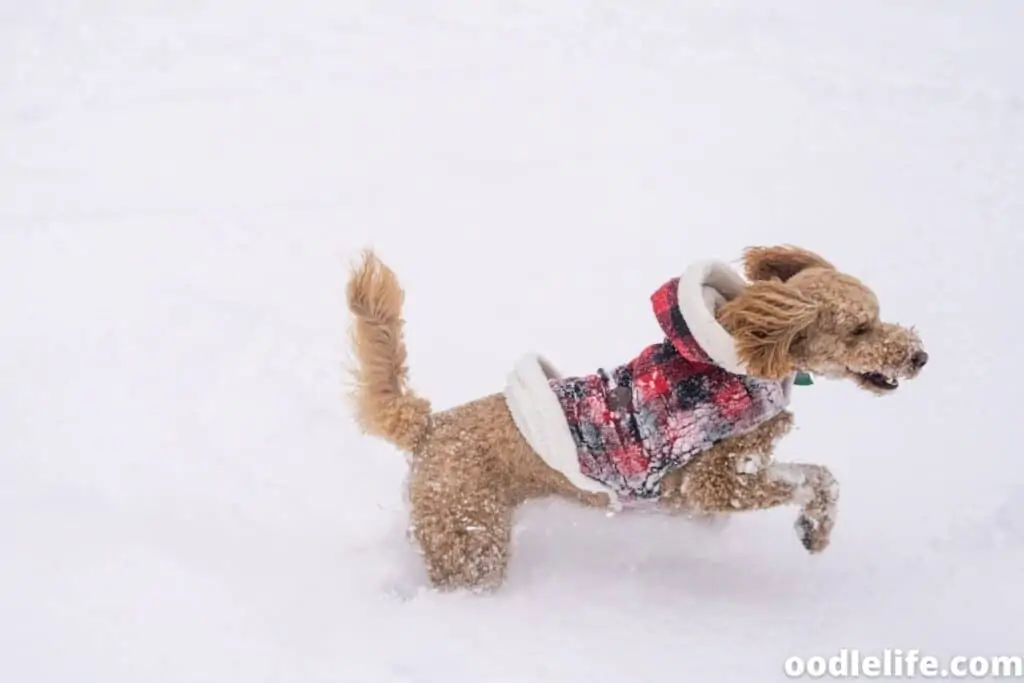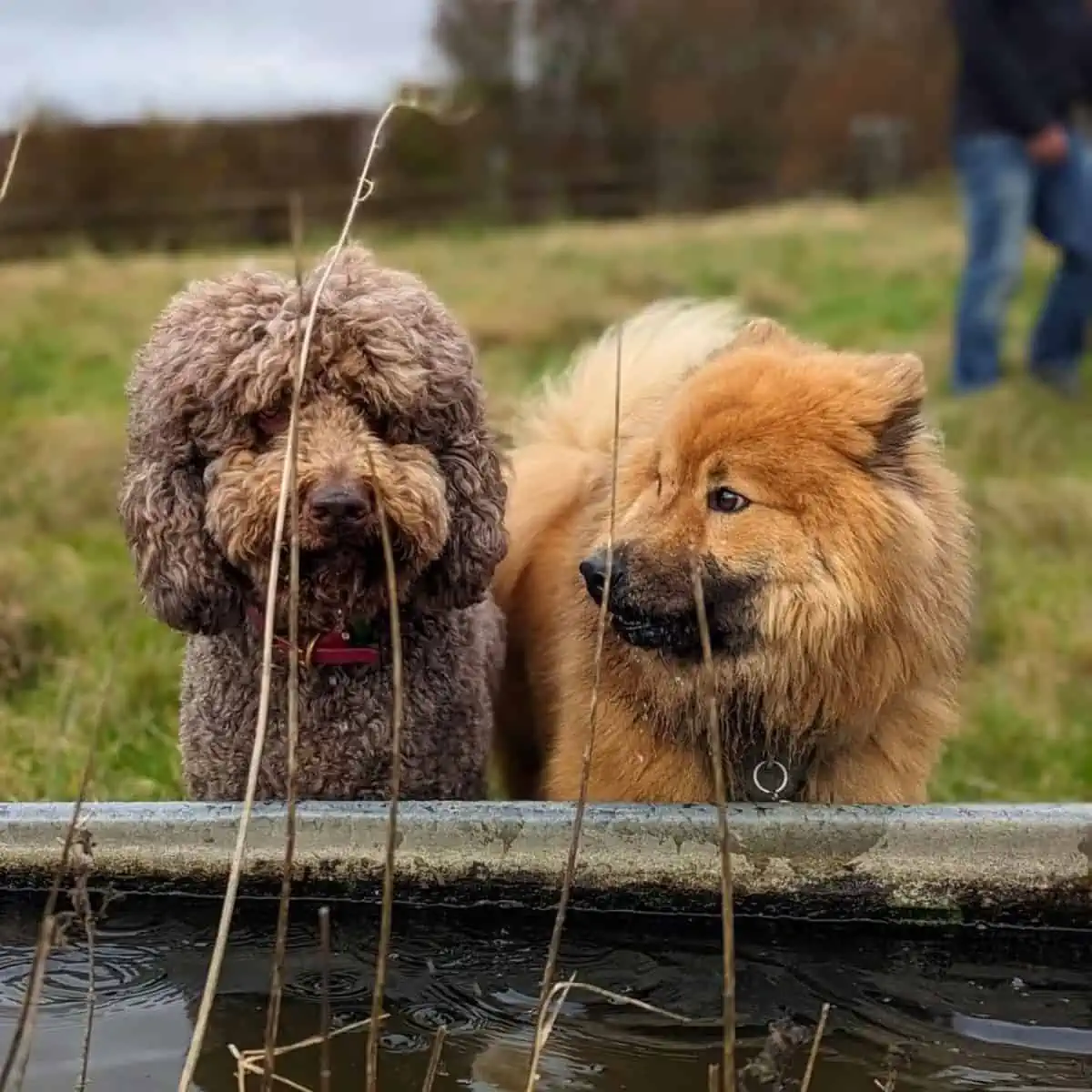Are Labradoodles Aggressive?
Many dog owners and lovers tend to go for Labradoodles because of their intense loyalty and keen emotional support.
Although loyalty is one of the reasons people tend to gravitate towards Labradoodles, many can’t help but wonder if their loyalty and protectiveness make them territorial. Are Labradoodles aggressive?
Labradoodles are known for their gentle nature and generally don’t display aggressive behavior. For most Labradoodle owners, aggression is unlikely to be a problem.
Sometimes Labradoodles DO display aggression as a puppy. This can typically be overcome with good training.

Labradoodles tend to start exhibiting traits of territorial aggression when they’re between the ages of 1 and 4 years when they become more confident.
Labradoodles are pretty friendly and social, which means that they only get territorial when they feel threatened. They will try to form close relationships with other animals and people. Knowing why your dog behaves the way they do is an essential factor for one to understand how to train and take care of your dog.
Causes of Labradoodle Aggression

Dogs, in general, usually have particular reasons and causes for their aggression. Although each case has its differences, we can cite reasons and experiences that increase aggressive tendencies of dogs like the Labradoodle. Here are some of the causes of aggression in dogs:
- New and scary experiences: Every dog reacts differently to new and frightening experiences, and new experiences might make your dog more aggressive.
- Physical abuse: Physical abuse makes dogs skittish, shy, and aggressive. It will cause your dog’s reaction to things highly unpredictable, which means they tend to become quite aggressive.
- Pain: If a dog is in pain because of an injury or any pain, there is an increased tendency for them to become aggressive because of their self-preservation instincts.
- Illness: If your dog is ill, it could become uncomfortable, which can lead them to lash out aggressively.
- Lack of feeding: Not feeding your Labradoodle, or neglect in general, will make them trust people less. This lack of trust can make your dog more aggressive.
Types of Aggression
There are three main types of aggression that Labradoodles exhibit. They are:
- Territorial aggression
- Possessive aggression
- Protective aggression
These three types of aggression are similar, and they are exhibited in the same behaviors that include:
- Biting
- Barking
- Snipping
The type of aggressive behaviors your dog shows depend mainly on its reasons for being aggressive. When a labradoodle is exhibiting aggression, it’s usually through barking, which is typically a sign of territorial or protective aggression.
Labradoodles rarely bite unless they suspect there is danger or a threat. They tend to go back to their playful and loving behavior as soon as the threat is removed.
Pet owners need to understand that their Labradoodle can exhibit aggressive behavior to both real and false threats (like the post man or a noisy kid) , so it’s up to them to determine what their dog believes to be a threat. The three types of aggression are:

Territorial Aggression
This type of aggression a dog exhibits when they believe there is a threat to their territory or area. A dog’s territory doesn’t just include their bed and your home, but can also be the places they pee and frequently take walks to. To understand this better, read the example below:
Imagine you see your labradoodle barking incessantly at nothing in your backyard until you go closer and see that a stranger and their dog are passing by.
Your dog smelt the unfamiliar scents of both the stranger and their dog and perceived them as threats. They won’t stop barking until after they have passed by and gone far enough that they can’t smell their scent anymore.

Possessive Aggression
A dog develops possessive aggression when they feel like a threat towards an object or area dear to them. It is usually displayed about things like food, toys, beds, and water. Read the example below for a better understanding of this type of aggression:
For example, your dog sees another dog going towards the food you served them in their personalized food dish. They immediately become alert and run towards the dish, barking at the other dog that’s trying to eat out of their plate.
Most times, your dog is just trying to get to the food first, not attack the other dog. When your labradoodle reaches their food, they’ll bark at the other dog while making sure that they have their food alone.

Protective Aggression
Dogs exhibit this type of aggression when they sense a threat towards their pack. Note that a dog’s pack consists of both their humans and other animals. They are usually the humans and animals the dog lives with or sees every day or quite often.
Labradoodles are pretty loyal, which means they tend to exhibit protective aggression. Read the example below to understand this type of aggression:
Imagine you and your Labradoodle are playing or running together, and then a new neighbor knocks on your front door to say hi. Because your labradoodle doesn’t know the person and has never smelt them before, they immediately go on guard.
Your labradoodle runs to the front door and starts barking at your new neighbor that was trying to be polite.
You open the door to say hi to the neighbor and see that your labradoodle hasn’t stopped barking. They have positioned themselves between you and your neighbor in a sweet and loyal way of defending you.
As soon as you and your neighbor finish exchanging pleasantries and they leave, your labradoodle becomes playful again, since the perceived threat has gone.

Signs of Labradoodle Aggression
How can you tell if your labradoodle is behaving aggressively instead of being a playful and loyal dog? What are the body language signs they exhibit? Finding out the answers to these questions can help you quickly figure out and anticipate your dog’s aggressive behavior.
Unless your dog has Sudden Onset Aggression Syndrome, you can always predict an aggressive attack by your dog’s behavior and traits. These are some of the signs that most Labradoodles exhibit, which precedes aggression:
- Snipping
- Biting, but with a higher intensity —going from playful nips to puncturing bites
- Stiff posture
- Growling
- Incessant barking
- Snarling
- Pinned back ears
- Bared teeth

Whether a dog is a purebred AKC approved, a designer dog or even mutt dog – any dog can display aggressive tendencies.
How to Handle an Aggressive Labradoodle
Dealing with and handling an aggressive Labradoodle can feel impossible because Labradoodles are usually the sweetest, most loving, and loyal dogs. [Although sometimes a little hyper]
Their charming personality and temperament make dealing with aggression much easier. Labradoodles are sensitive dogs, so yelling at them will do more harm than good.
The best thing to do is to start socializing with your dog during puppyhood. Socializing and training your puppy will go a long way to reduce their risk of becoming aggressive as they grow older.
One way that works well is letting your aggressive Labradoodle spend time with a well-behaved and calm dog. This will help your dog pick up on the other dog’s behavior. It’s pretty rare for a dog to become aggressive with a well-behaved dog that doesn’t trigger his aggression.
As we said earlier, yelling at a Labradoodle is the wrong way to go about things. Yelling at your labradoodle will only make them repeat their aggressive behavior later.
They are pretty sensitive, so being too hard on your labradoodle will discourage them from listening to you. Labradoodles tend to respond better to positive reinforcement and praise.
If your dog wasn’t trained or socialized as a puppy, you can still do something about it. It might take a little longer and a lot more patience, but eventually, your dog will know the right things to do.
If you feel discouraged, remind yourself that it takes longer to socialize a fully grown and aggressive labradoodle, but the reward is definitely worth the hard work.

The Bottom Line
Labradoodles are loyal, protective, and caring dogs. They are lovely family pets and companions. If you socialize and train your dog correctly, your Labradoodle won’t misbehave or show unnecessary and inappropriate aggression. You will find yourself with a well-behaved adult labradoodle, which is one of the reasons this breed is gaining popularity.